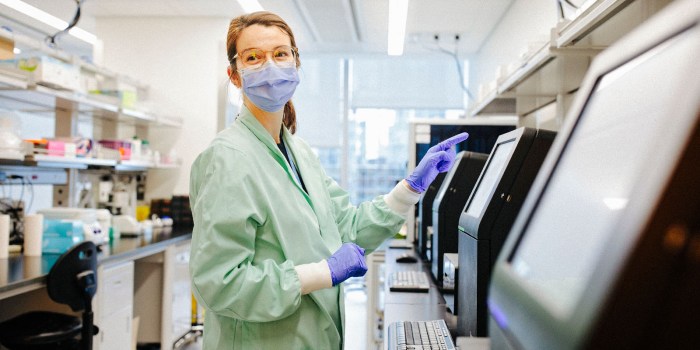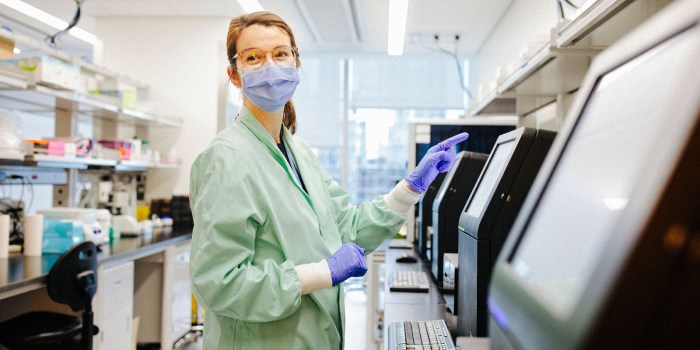
Clinical scientist histocompatibility and immunogenetics is a fascinating field at the intersection of medicine and genetics. It explores the intricate ways our immune systems react to foreign tissues, particularly in transplantation. This involves understanding the crucial role of histocompatibility, focusing on matching donor and recipient tissues to minimize rejection, and delving into the complexities of immunogenetics, which explores the genes controlling immune responses.
The field’s evolution, from its historical roots to the latest advancements, is a story of continuous innovation and discovery.
This exploration will cover the fundamental immunological mechanisms driving transplant rejection, detail the critical histocompatibility testing and matching methods, and examine the interplay between immunogenetics and various diseases. It will also analyze the ethical considerations inherent in this field and discuss the potential for future research and applications. The intricate relationship between genes, immune response, and disease is at the heart of this discussion.
Introduction to Clinical Scientist Histocompatibility and Immunogenetics
Histocompatibility and immunogenetics are crucial branches of clinical science that focus on the intricate relationship between the immune system and tissue transplantation. Understanding how the body recognizes and reacts to foreign tissues is paramount in organ transplantation and disease diagnosis. This field encompasses the study of genes that determine tissue compatibility, enabling us to predict the likelihood of rejection and tailor treatment strategies for optimal outcomes.The significance of this field in modern medicine stems from the increasing need for organ transplantation and the rising prevalence of autoimmune diseases.
Accurate matching of donor and recipient tissues minimizes the risk of rejection, thereby extending the lifespan of transplant recipients and improving their quality of life. Understanding the genetic basis of immune responses also allows for targeted therapies and diagnostics, ultimately leading to more effective and personalized treatments for a wide range of diseases.
Historical Context and Evolution
The field of histocompatibility and immunogenetics has evolved significantly over the past century. Early observations of tissue rejection in animal models laid the foundation for understanding the complexities of the immune system. The discovery of major histocompatibility complex (MHC) genes in the 1950s revolutionized the field, providing a crucial framework for understanding tissue compatibility and immune responses. This landmark discovery enabled more precise matching of donor and recipient tissues, leading to improved outcomes in organ transplantation.
Further research delved into the intricate mechanisms of immune responses and the genetic basis of individual variations in immune responses. The development of sophisticated molecular techniques, such as polymerase chain reaction (PCR) and DNA sequencing, accelerated the pace of research, leading to a deeper understanding of the genetic basis of histocompatibility and immunogenetics.
Key Milestones in Histocompatibility and Immunogenetics Research
The development of this field has been marked by several key milestones. These milestones represent significant breakthroughs in our understanding of tissue compatibility and immune responses.
| Year | Milestone | Impact |
|---|---|---|
| 1950s | Discovery of the major histocompatibility complex (MHC) genes | Provided a framework for understanding tissue compatibility and immune responses, enabling more precise matching of donor and recipient tissues. |
| 1970s | Development of tissue typing techniques | Enabled more accurate identification of histocompatibility antigens, improving the success rate of organ transplantation. |
| 1980s | Application of molecular biology techniques | Accelerated the pace of research, leading to a deeper understanding of the genetic basis of histocompatibility and immunogenetics. |
| 1990s | Development of more sophisticated tissue typing techniques | Allowed for more accurate matching of donor and recipient tissues, resulting in a lower risk of rejection and improved outcomes in organ transplantation. |
| 2000s-present | Advances in genomics and immunology | Led to a deeper understanding of the complex interactions between genes and the immune system, facilitating the development of more personalized and effective treatments for autoimmune diseases and other immune-related disorders. |
Immunological Mechanisms in Transplantation
Transplantation, a life-saving procedure, faces a significant hurdle: the recipient’s immune system recognizing the transplanted organ (allograft) as foreign and mounting an attack. Understanding the intricate immunological mechanisms behind this rejection is crucial for developing effective immunosuppressive strategies. This knowledge empowers clinicians to predict rejection risk, tailor immunosuppression regimens, and ultimately improve patient outcomes.The immune system’s response to an allograft is multifaceted, involving various cells and molecules.
The body’s recognition of the allograft as foreign is primarily driven by differences in the major histocompatibility complex (MHC) molecules on the surface of the donor and recipient cells. These differences trigger a cascade of events leading to the rejection process.
Major Histocompatibility Complex (MHC) Molecules in Transplant Rejection
MHC molecules, also known as human leukocyte antigens (HLAs), are crucial for immune system recognition. They present peptides derived from both self and foreign proteins on the cell surface. These presented peptides are critical in determining if a cell is “self” or “non-self”. Donor-recipient mismatch in MHC molecules leads to the activation of recipient T cells, initiating an immune response that targets the allograft.
The degree of MHC mismatch directly correlates with the likelihood of transplant rejection. Precise matching of HLA types between donor and recipient is a significant factor in minimizing the risk of rejection.
Different Types of Immune Responses in Transplantation
Immune responses in transplantation can be broadly categorized into several types, each with distinct mechanisms and outcomes. The primary types include cellular and humoral responses. Cellular rejection, mediated by T lymphocytes, is a dominant factor in the early stages of allograft rejection. Humoral rejection, mediated by antibodies, is more prevalent in later stages and is often associated with a pre-existing immune response to the donor’s antigens.
Understanding these distinct immune pathways is vital in developing targeted therapies to mitigate transplant rejection.
Role of T Cells and Antibodies in Transplant Rejection
T cells, a critical component of the cellular immune response, play a central role in transplant rejection. These cells recognize and attack donor cells expressing non-self MHC molecules. Different subtypes of T cells, including cytotoxic T lymphocytes (CTLs), mediate the direct destruction of allograft cells. Moreover, T helper cells orchestrate the overall immune response. Antibodies, produced by B lymphocytes, also contribute to rejection.
These antibodies can bind to donor cells, triggering complement-mediated lysis or antibody-dependent cellular cytotoxicity (ADCC). The interplay between T cells and antibodies is often complex, with each contributing to different aspects of the rejection process.
Key Players in the Immune Response to Allografts, Clinical scientist histocompatibility and immunogenetics
| Component | Role | Impact |
|---|---|---|
| Major Histocompatibility Complex (MHC) molecules | Present peptides derived from donor proteins, triggering immune response | Directly correlates with likelihood of transplant rejection |
| Cytotoxic T Lymphocytes (CTLs) | Directly kill donor cells expressing non-self MHC molecules | A major contributor to cellular rejection |
| T Helper Cells | Orchestrate the overall immune response | Coordinate the activity of other immune cells |
| Antibodies | Bind to donor cells, triggering complement-mediated lysis or ADCC | Contribute to humoral rejection, especially in later stages |
| B Lymphocytes | Produce antibodies | Mediate humoral immune response |
| Complement System | Enhances the inflammatory response | Contributes to antibody-mediated cell destruction |
Histocompatibility Testing and Matching
Matching compatible donor and recipient tissues is crucial for successful organ transplantation. This process, often referred to as histocompatibility testing, involves identifying and comparing the human leukocyte antigen (HLA) genes between the potential donor and recipient. Accurate matching minimizes the risk of rejection, allowing the transplanted organ to function properly and prolong the recipient’s life. Understanding the methods and importance of HLA typing is paramount in optimizing transplant outcomes.
Methods for Histocompatibility Testing
Precise histocompatibility testing is essential for selecting suitable donors. The primary method relies on identifying the specific HLA genes and alleles present in both the donor and recipient. This process is complex, requiring sophisticated techniques and skilled personnel.
Clinical scientists specializing in histocompatibility and immunogenetics are crucial for understanding the intricate immune system, especially in transplant procedures. However, rapid advancements in technology, like hitech could catch healthcare service providers with their pants down , mean healthcare providers need to adapt quickly. This necessitates ongoing education and skill development for these clinical scientists to ensure patient safety and optimal outcomes in the face of evolving technologies.
HLA Typing in Transplantation
The human leukocyte antigen (HLA) system plays a pivotal role in transplant success. HLA genes encode proteins that are crucial for the immune system’s ability to distinguish between self and non-self tissues. Significant differences in HLA between donor and recipient can trigger an immune response, leading to graft rejection.
Clinical scientists specializing in histocompatibility and immunogenetics are crucial for understanding the intricate immune system. Their work often involves complex research, and as a result, they’re constantly seeking new tools and resources. For instance, advancements in software development, like the ones that WinPho developers are currently enjoying, can streamline research processes. This exciting development in WinPho developers get a bite of the mango opens new avenues for progress in this field, allowing for more precise and efficient study of immune responses.
Ultimately, this benefits the entire clinical scientist histocompatibility and immunogenetics community.
HLA Typing Techniques
Several techniques are employed to identify HLA alleles. These techniques vary in their complexity, cost, and accuracy.
| Method | Principle | Advantages | Disadvantages |
|---|---|---|---|
| Sequence-based typing (SBT) | Direct sequencing of HLA genes. | High resolution and accuracy, especially for identifying rare alleles. | Expensive, time-consuming, and requires specialized equipment. |
| DNA-based typing | Using polymerase chain reaction (PCR) and specific probes to identify HLA alleles. | Relatively fast, affordable, and widely accessible compared to SBT. | Lower resolution than SBT, and may not detect all alleles. |
| Serotyping | Detecting HLA antigens through antibody reactions. | Relatively simple and less expensive than molecular methods. | Lower resolution, limited ability to detect rare alleles. |
Role of Tissue Typing in Donor Selection
Tissue typing, particularly HLA typing, is critical for identifying compatible donors. By comparing the HLA profiles of the potential donor and recipient, clinicians can determine the degree of compatibility. The more similar the HLA profiles, the lower the risk of rejection. This process is often complex, requiring careful consideration of various factors, including the patient’s medical history, and the donor’s availability.
Matching donors and recipients by HLA type allows for the successful transplantation of organs and tissues, improving patients’ quality of life. For instance, a patient with a rare HLA type might have limited donor options, highlighting the need for comprehensive and accurate tissue typing. In summary, accurate HLA matching is paramount in minimizing the risk of graft rejection and maximizing the success rate of organ transplantation.
Immunogenetics and Disease: Clinical Scientist Histocompatibility And Immunogenetics

The intricate dance between our genes and our immune system shapes our susceptibility to various diseases. Immunogenetics, the study of how genes influence immune responses, provides invaluable insights into the complex interplay between our genetic makeup and our health. Understanding these genetic factors is crucial for developing targeted therapies and preventative strategies for a wide range of conditions.
HLA Genes and Autoimmune Diseases
HLA (Human Leukocyte Antigen) genes are a crucial part of the immune system, encoding proteins that present antigens to immune cells. Variations in these genes significantly impact immune responses, potentially leading to autoimmune disorders. Individuals with specific HLA alleles may have a heightened predisposition to developing autoimmune diseases, where the immune system mistakenly attacks the body’s own tissues.
This predisposition stems from a mismatch between the presented antigens and the immune system’s recognition mechanisms.
Immunogenetics in Autoimmune Disorders
Immunogenetics plays a critical role in understanding and managing autoimmune disorders. By identifying specific HLA alleles associated with particular diseases, researchers can better understand the underlying genetic risk factors. This knowledge is instrumental in identifying individuals at higher risk and tailoring preventative measures or treatment strategies. For example, understanding the genetic predisposition to rheumatoid arthritis can guide early intervention and potentially mitigate disease progression.
Immunogenetics in Inflammatory Diseases
Similar to autoimmune diseases, immunogenetics is instrumental in understanding inflammatory diseases. Inflammatory conditions, like Crohn’s disease and ulcerative colitis, involve chronic inflammation of the digestive tract. Specific HLA alleles can increase the risk of developing these inflammatory conditions, suggesting a genetic component to their onset and progression. This knowledge can be utilized in personalized medicine, helping to identify individuals with a higher genetic risk for developing inflammatory diseases and providing early intervention strategies.
Association of HLA Alleles with Diseases
The following table illustrates the association of specific HLA alleles with various diseases. It is important to remember that these associations represent increased risk, not absolute certainty of disease development. Environmental factors and other genetic variations also contribute to the complex etiology of these conditions.
| Disease | Associated HLA Alleles | Risk |
|---|---|---|
| Rheumatoid Arthritis | HLA-DRB1*0401, HLA-DRB1*0404 | Increased |
| Type 1 Diabetes | HLA-DR3, HLA-DR4 | Increased |
| Celiac Disease | HLA-DQ2, HLA-DQ8 | Increased |
| Multiple Sclerosis | HLA-DRB1*1501 | Increased |
| Crohn’s Disease | HLA-DRB1*0103 | Increased |
| Ulcerative Colitis | HLA-DRB1*0103, HLA-DQB1*0201 | Increased |
Applications and Future Directions

The field of histocompatibility and immunogenetics is constantly evolving, driving advancements in transplantation and disease treatment. Understanding the intricate interplay between immune responses and tissue compatibility is crucial for successful organ transplantation and the development of novel therapies for immune-mediated diseases. This section explores the clinical applications of this knowledge, recent advancements, potential future directions, and the impact of genomics on the field.
Clinical Applications
Histocompatibility and immunogenetics have a profound impact on clinical practice. Accurate matching of donor and recipient tissues in transplantation is critical for minimizing rejection and maximizing graft survival. This includes not only solid organ transplantation (kidney, liver, heart, lung) but also hematopoietic stem cell transplantation. Furthermore, understanding the immunogenetic basis of diseases like autoimmune disorders and cancers allows for targeted therapies and improved patient outcomes.
The information derived from histocompatibility testing aids in preventing graft rejection and enables better patient selection for transplantation procedures.
Recent Advancements
Significant strides have been made in recent years. Next-generation sequencing (NGS) technologies are revolutionizing the identification of HLA alleles, facilitating more precise matching and personalized treatment strategies. Improved understanding of the complex interactions between immune cells and transplanted tissues is leading to the development of novel immunosuppressive agents and strategies for preventing rejection. For example, the identification of specific immune response pathways associated with rejection can lead to targeted interventions.
Researchers are also focusing on the role of non-HLA genes in transplantation success, which could further refine tissue matching and improve long-term graft outcomes.
Potential Future Research Directions
Future research should focus on expanding the scope of histocompatibility testing to encompass a wider array of genetic markers, possibly including epigenetic modifications and other non-coding DNA regions. This will lead to more comprehensive understanding of individual immune responses, enabling the development of more effective and personalized treatment strategies for transplantation and immunologic diseases. Investigating the role of the microbiome in modulating immune responses in transplantation settings is another promising area.
Clinical scientists in histocompatibility and immunogenetics are constantly wrestling with complex issues, like matching tissues for transplants. This intricate work often parallels the “do not track balancing act” the do not track balancing act , where finding the right balance between data collection and user privacy is crucial. Ultimately, these scientists are dedicated to pushing the boundaries of understanding immune systems and ensuring the best possible outcomes for patients.
Additionally, development of novel bioinformatics tools for analyzing large-scale genomic data will accelerate the identification of new markers for disease prediction and personalized therapies.
Examples of Current Clinical Trials
Several clinical trials are actively investigating the application of histocompatibility and immunogenetics in transplantation. For example, trials are evaluating the use of novel immunosuppressive drugs targeting specific immune pathways, aiming to reduce the dosage of conventional immunosuppressants and minimize side effects. Some trials explore the role of specific HLA alleles in predicting transplant outcomes. Others investigate the use of NGS-based approaches to identify optimal HLA matches in a wider range of patients.
These ongoing trials are critical in translating research findings into tangible clinical benefits.
Impact of Genomics on Histocompatibility and Immunogenetics Research
Genomics is transforming the field. The availability of complete human genome sequences and powerful bioinformatics tools allows for the identification of novel genetic variations associated with immune responses and transplantation outcomes. This facilitates the development of personalized treatment strategies based on individual genetic profiles. Genomic studies are crucial in identifying specific genetic markers that predict the risk of graft rejection or response to immunotherapy.
The information gathered from genomic studies will enable the creation of more accurate models for predicting transplant outcomes and guiding personalized treatment strategies. For instance, genomics can predict an individual’s risk of developing an autoimmune disease based on their genetic predisposition, enabling preventative measures and early intervention.
Ethical Considerations
Organ donation and transplantation, while offering a lifeline to those in need, raise profound ethical concerns. Balancing the benefits of saving lives with the rights and well-being of donors and recipients requires careful consideration of various principles and potential consequences. Immunogenetic information, crucial for successful transplantation, also necessitates a cautious approach to maintain patient privacy and avoid discrimination.The field of histocompatibility and immunogenetics grapples with complex ethical dilemmas, requiring ongoing dialogue and adaptation to new scientific advancements.
These considerations extend beyond the immediate patient to broader societal implications, demanding careful consideration of potential future scenarios.
Ethical Implications of Organ Donation
The act of organ donation involves complex ethical considerations surrounding consent, informed decision-making, and the allocation of scarce resources. Issues of donor selection and the potential for coercion or undue influence must be meticulously addressed to ensure voluntary and ethical practices.
Ethical Implications of Immunogenetic Information
Immunogenetic information, while essential for matching donors and recipients, presents significant ethical challenges. The potential for discrimination based on genetic predispositions to disease or perceived health risks must be rigorously guarded against. Protecting patient privacy and ensuring the responsible use of such sensitive data are paramount.
Consent and Privacy in Histocompatibility Testing
Consent for histocompatibility testing and the subsequent use of immunogenetic data must be explicit, informed, and freely given. Individuals should be fully aware of the implications of testing, including the potential for data sharing and research purposes. Robust privacy protocols and safeguards are essential to prevent misuse and unauthorized access to sensitive information.
Key Ethical Principles in Histocompatibility and Immunogenetics
A set of fundamental ethical principles should guide all practices in histocompatibility and immunogenetics. These principles, rooted in respect for autonomy, beneficence, non-maleficence, and justice, ensure that procedures are conducted with the patient’s well-being and the broader societal good in mind.
- Respect for autonomy: Individuals have the right to make informed decisions about their health, including the decision to donate or receive organs and participate in research.
- Beneficence: Actions should be taken to maximize benefits and minimize harm for all involved.
- Non-maleficence: Procedures should be designed to avoid causing harm to donors or recipients.
- Justice: Fair and equitable allocation of resources, such as organs, should be implemented to ensure equal access.
- Confidentiality: Strict protocols must be in place to protect the privacy of immunogenetic information and prevent its misuse.
Societal Implications of Future Advances
Advancements in histocompatibility and immunogenetics, such as CRISPR technology, hold immense promise but also pose significant societal challenges. Careful consideration of the potential impact on genetic diversity, access to advanced therapies, and the potential for social stratification is crucial.
- Genetic diversity: Widespread use of genetic engineering could potentially reduce genetic diversity, which might have implications for the overall health of the population.
- Access to advanced therapies: High costs of advanced therapies could create disparities in access, potentially widening existing health inequalities.
- Social stratification: Genetic testing and therapies might contribute to social stratification, potentially exacerbating existing inequalities based on socioeconomic status.
Wrap-Up
In conclusion, clinical scientist histocompatibility and immunogenetics plays a pivotal role in modern medicine, particularly in transplantation. Understanding the intricate immunological mechanisms, refined histocompatibility testing, and the link between immunogenetics and disease are crucial. The field continues to evolve, promising exciting advancements in transplantation and treatment of immune-related disorders. The ethical considerations are equally vital, ensuring responsible application of this powerful knowledge.

